
US U26 Team Trials: Finn vs Olivia!

Summary:
Olivia, a member of Team Funbridge, introduces the competition
A board from Olivia in the Round Robin
Two swing hands from Finn’s perspective
Finn qualified to represent the United States as USA1!
Olivia, a member of Team Funbridge, introduces the competition
I recently had the pleasure of playing in the US Junior trials with Stella Wan in the Under 26 category. Our team (Cornelius Duffie-Jacob Freeman, Richard Jeng-Brent Xiao) was stacked with great players and awesome people.
This was an exciting reunion for Stella and me because she was my first-ever bridge partner. We played together for a few months when I was around 10 and she was 15.
Once, an opponent thought Stella was my mother, which started a 9 year long inside joke. Here is a picture of Stella and me after winning our first tournament
together!

Fast forward 9 years to the Junior trials. Before the games started, there was a training camp for all of the Juniors competing in the trials. This was thanks to expert players volunteering their time as mentors and countless hours of preparation from the organisers, particularly Amber Lin. My favourite lesson focused on “making your own luck”. The idea is to make your opponents’ decisions more difficult so that they make more errors. This idea stuck with me through the tournament, and it will come up in a hand I share in this article.
After the training camp ended, we jumped right into a one-and-a-half-day round-robin with nine teams. The top four teams would qualify for the USA1 bracket, with the next four making the USA2 bracket and the last finisher being eliminated.

This selection takes place every two years, and Finn Kolesnik (a member of Team Funbridge) has always won it.
This time, his team consists of Harrison Luba, Bruce Zhu, Michael Hu, Ethan Wood, and his partner, Michael Xu.
A board from Olivia in the Round Robin
I loved this board from the round robin:
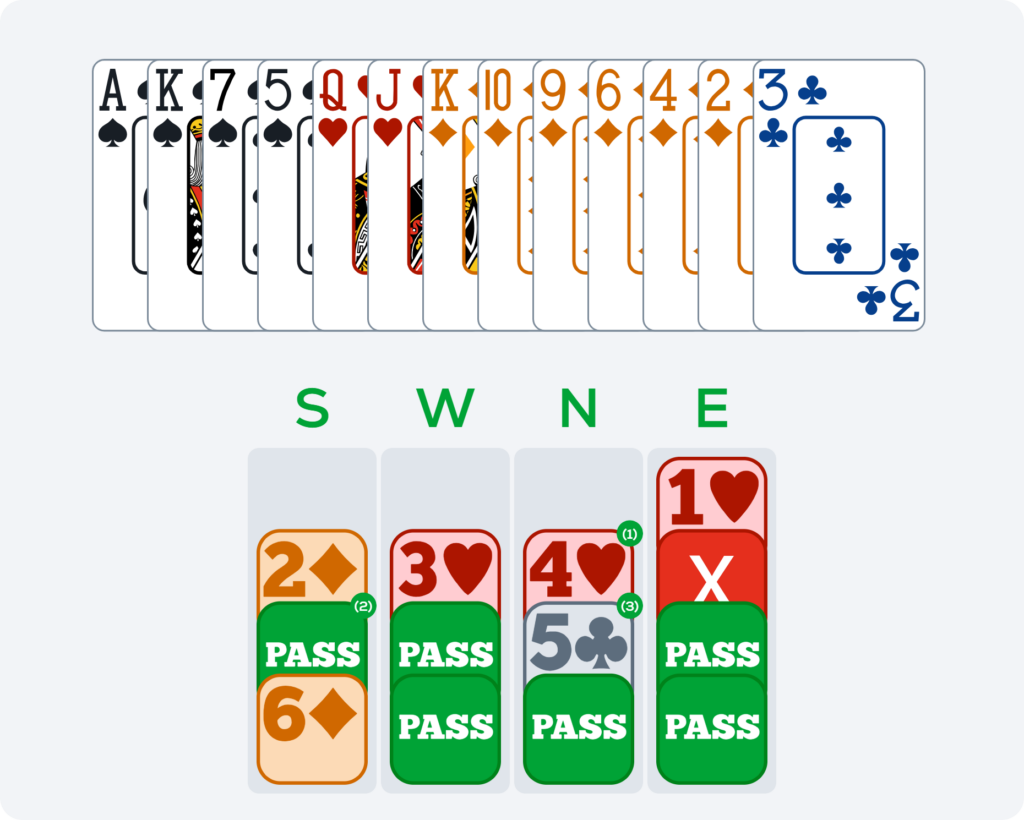
(1) 4♥: strong support for diamonds.
(2) Pass: denies a control in hearts.
(3) 5♣: shows a control in hearts and interest in a slam.
At first glance, my hand seems disappointing with my useless queen-jack of hearts, but it still holds good slam potential. Imagining my partner with Kxx x AKxx Kxxxx, the slam is excellent. It is also excellent with as little as xx x Axxxx Axxxx, though my partner should hold more. So, I chose to jump to 6♦.
Here, my partner held ♠42 ♥9 ♦AQ53 ♣AJ10765, and 6♦ was the best contract. We were the only ones to reach 6♦, and +920 earned us a 13 IMP win on the board.
Everything was going our way in the round robin. We finished with a butler of +2.5 over 50 boards. Our team-mates were playing extremely well and we finished first in the round robin. Next, we played Team Zheng in the USA1 semi-finals.
The winner would go on to the USA1 final, while the loser would go on to the USA2 quarter-final. We got off to a strong start, winning the first quarter by 59 IMPs! The rest of the day went smoothly, and we ended up winning by 78 IMPs. Meanwhile, Finn and his team secured a comfortable victory against Team Chen.
Next up was a tough match in the USA1 final against Team Kolesnik, captained by Team Funbridge member Finn Kolesnik.
Two swing hands from Finn’s perspective
We began the two-day final against Olivia’s team and had a great start to be up 36 IMPs. About half-way through the second set I was dealt this hand:
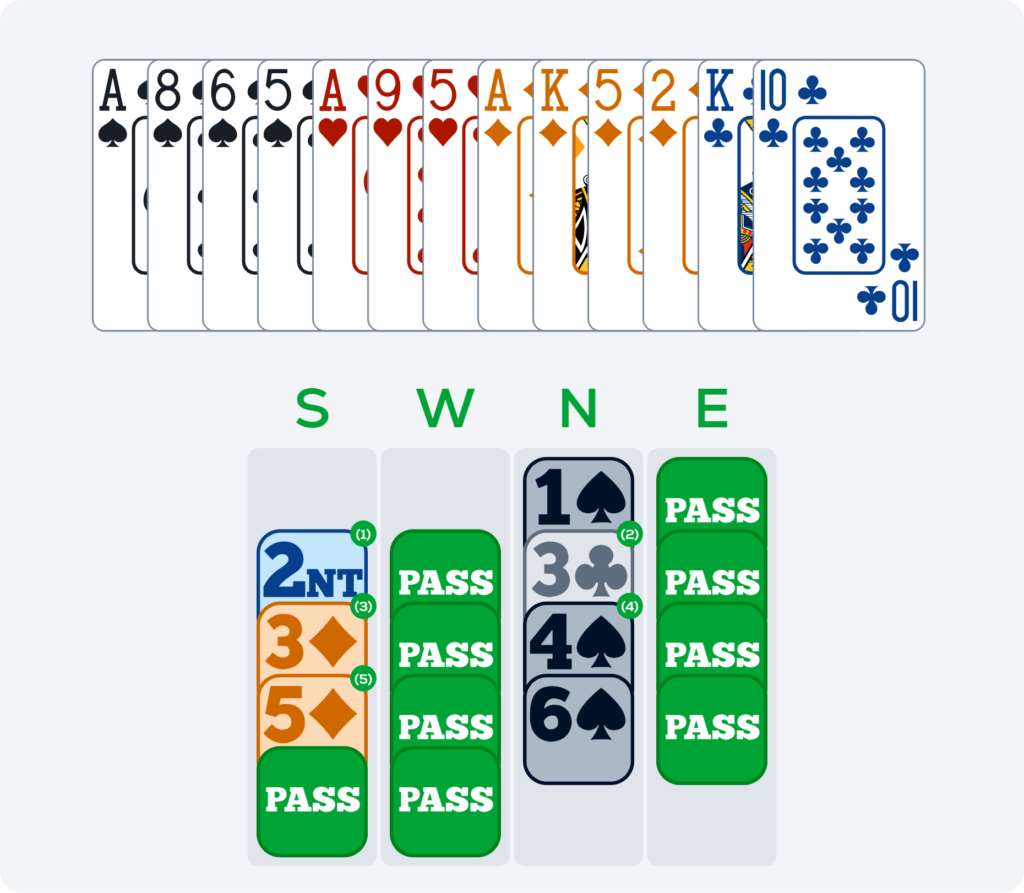
(1) 2NT: game-forcing with at least a four-card fit
(2) 3♣: minimum hand
(3) 3♦: relay
(4) 4♠: 5332 distribution
I tried to imagine hands corresponding to this auction, and many pointed towards a slam or were highly promising. I therefore decided to involve my partner by bidding 5♦, hoping he would value his ace of clubs enough to make the right decision. If he had bid 5♥ as a “last train” cue, I would have stopped the auction, but instead, he jumped to 6♠.
The full deal:
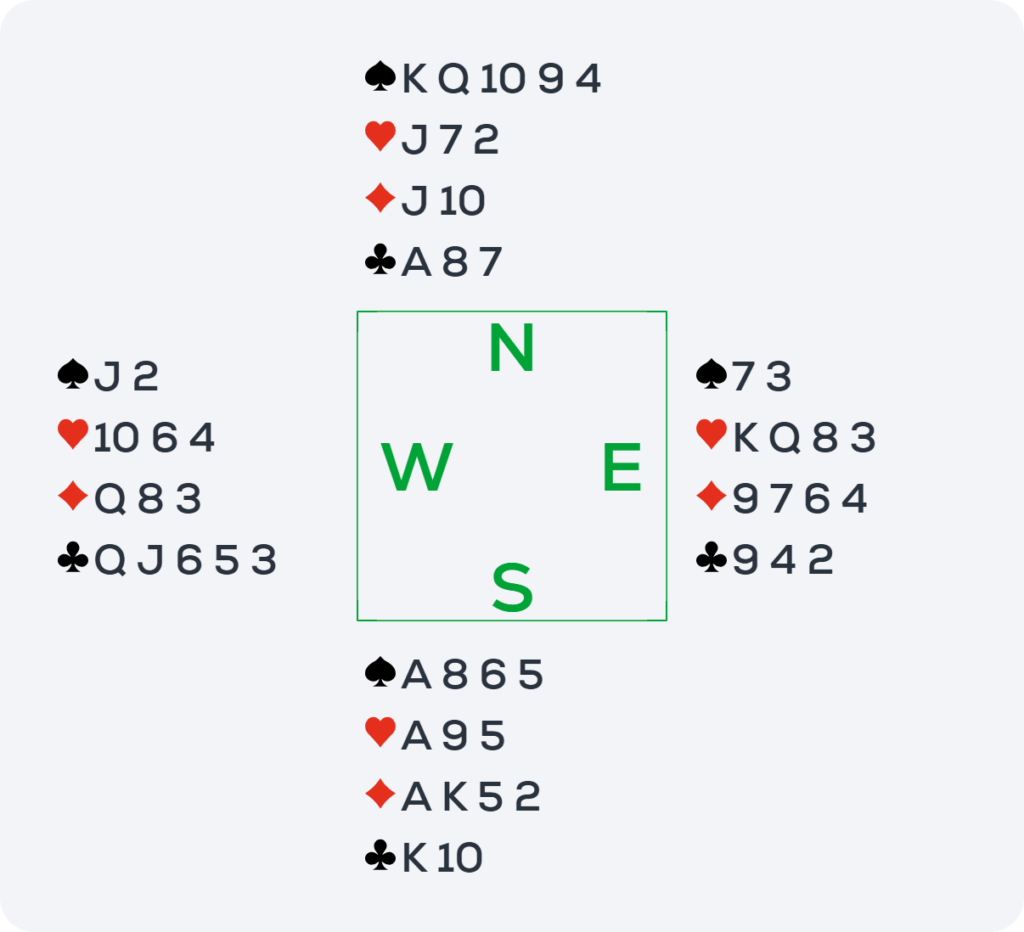
On a lead other than hearts, my partner in North had a secure contract thanks to the diamond finesse, as he could discard two hearts on the ace and king of diamonds. On a heart lead, the contract depended on the diamond finesse. At our table, Michael played straightforwardly by winning the ace of hearts and attempting the diamond finesse, resulting in one down. At the other table, the declarer made an elegant play at trick one by ducking the opening lead. This introduced a psychological element, prompting the defence to switch to a trump.
Without the queen, East might have returned a diamond, especially with three small ones. With the queen, it’s more challenging. On the other hand, if East held four diamonds, the declarer could play ace-king of diamonds, ruff a diamond, and then squeeze East in hearts and diamonds on the final trump.
The declarer then sought to gather as much information as possible before making a decision. He began by drawing trumps (2-2), then played a club to the king. On the second round of clubs, West covered with the queen, revealing the jack. He then ruffed the third club in dummy, noticing both defenders following with small cards. On the fourth round of trumps, East discarded a small heart, and West a small club, confirming queen-jack fifth.
At this point, the declarer had to choose between East’s two likely distributions: 2443 or 2533, with the queen-third in diamonds. To decide, West might have discarded a heart if holding a doubleton heart, but here, he likely retained his probable Txx.
The declarer then played the jack of diamonds to create one last psychological opportunity — a simulated finesse. Once East followed small, the declarer executed the squeeze. It was better played and cost us 14 IMPs.
A beautiful combining chances
After this segment, our 36 IMP lead had dwindled to just 7 points. Fortunately, we won segments 3 through 5 before I faced this critical decision in segment 7, with a lead of approximately 46 IMPs:
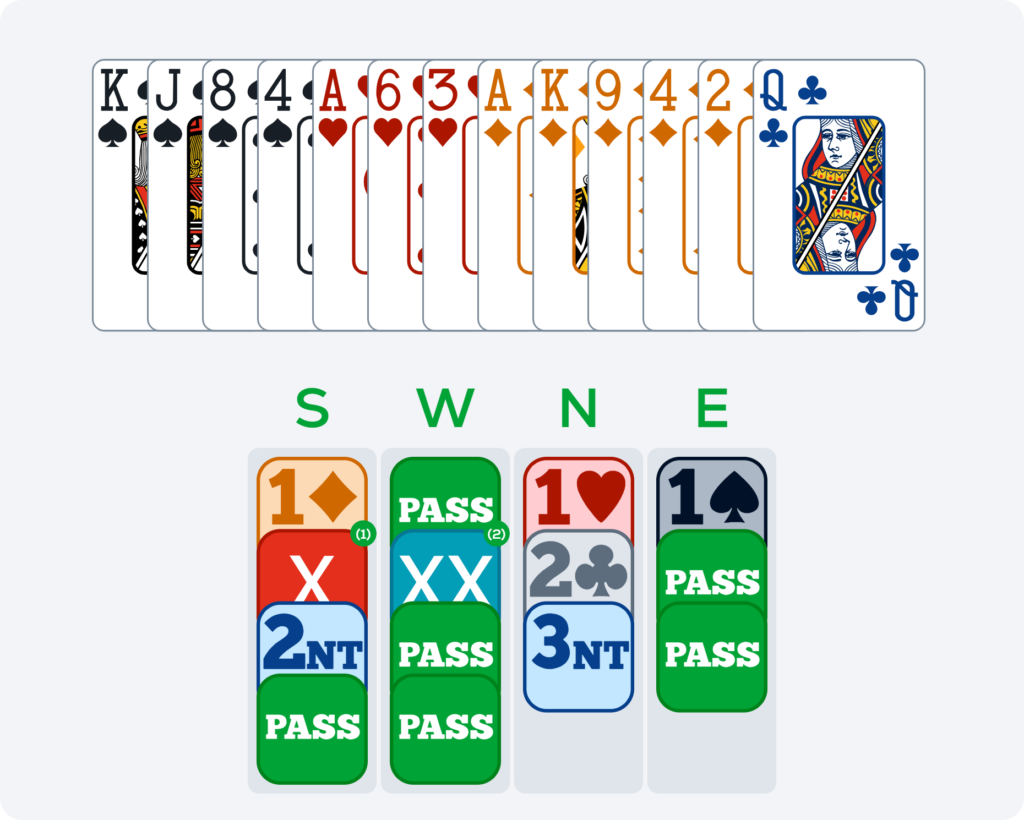
(1) 1NT shows a balanced hand with 17-18 points, but I chose a support double to better describe my hand.
(2) XX: exactly two cards in ♠ and constructive values (around 7+ points).
The opening lead was the jack of diamonds (indicating the queen in their system), and I got to see the dummy:
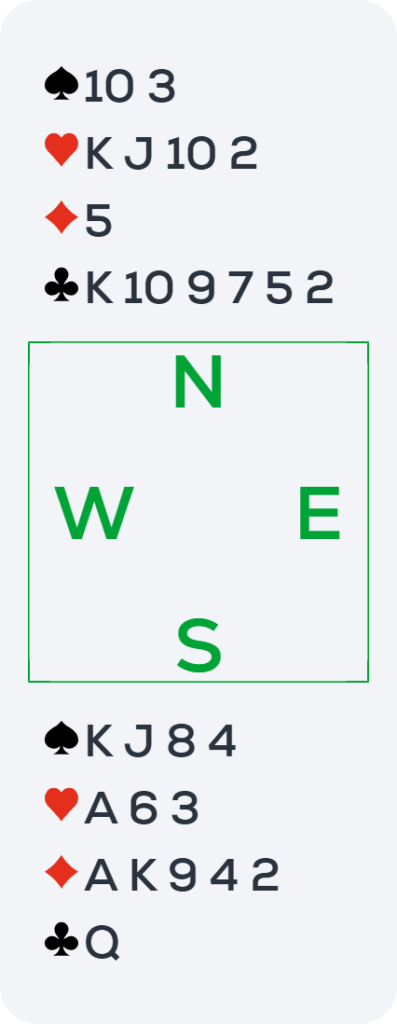
The first deduction I made was that the ace and queen of spades were likely to my right, as the suit was not led. Another probable scenario: I would need the queen of hearts to be well-placed to reach nine tricks, as I have no entries to the dummy. If it is well-placed, I could dislodge the ace and jack of clubs (catching the queen under the king if they duck) to score four clubs, two diamonds, and three hearts.
The problem with this plan is that if they continue diamonds, I risk losing two tricks in that suit, two clubs, and the ace of spades, leading to one down.
Another idea, based on the heart finesse, would be to play a heart towards the jack and attempt a double finesse in spades, aiming for two diamonds, two spades, four hearts, and one club (by establishing it). This line minimises the risk of five losers. However, it requires the queen of hearts and ace-queen of spades to be well-placed, which seems like a lot to hope for.
So, what did I decide? Neither option. I started by ducking the first diamond, delaying my decision. After ducking, I could still choose either line, and there was a good chance the defence would help me out. That’s exactly what happened: West cashed the ace of spades before switching to a spade, leading to the 10 that held on the dummy.
From there, I deduced that East likely held all the remaining high cards, as without a solid spade suit, they probably wouldn’t have overcalled without the ace of clubs and the queen of hearts. I then proceeded with the heart finesse by playing the jack from the dummy, which held. If hearts were 3-3, I could cash four hearts, two spades, one club, and two diamonds. If not, I’d need to establish an extra trick.
Next, I played a club from the dummy, winning a trick when East ducked. The only risk to my contract at this point was if East held four hearts, leaving two possible distributions: 5-4-2-2 or 5-4-1-3 (as they must still have the ace of clubs, ruling out a singleton club). In either case, I could squeeze East and then endplay them by playing the ace and king of diamonds, discarding clubs from the dummy.
East discarded a club and then a spade. From there, it was straightforward to conclude the hand: I played the ace of hearts, a heart to the king, and then endplayed East with the 4th heart, forcing them to give me two spade tricks at the end. If East had been 5-3-1-4, I would have cashed my 4th heart and played the king of clubs, forcing them to concede an extra trick in either clubs or spades.
The full deal:
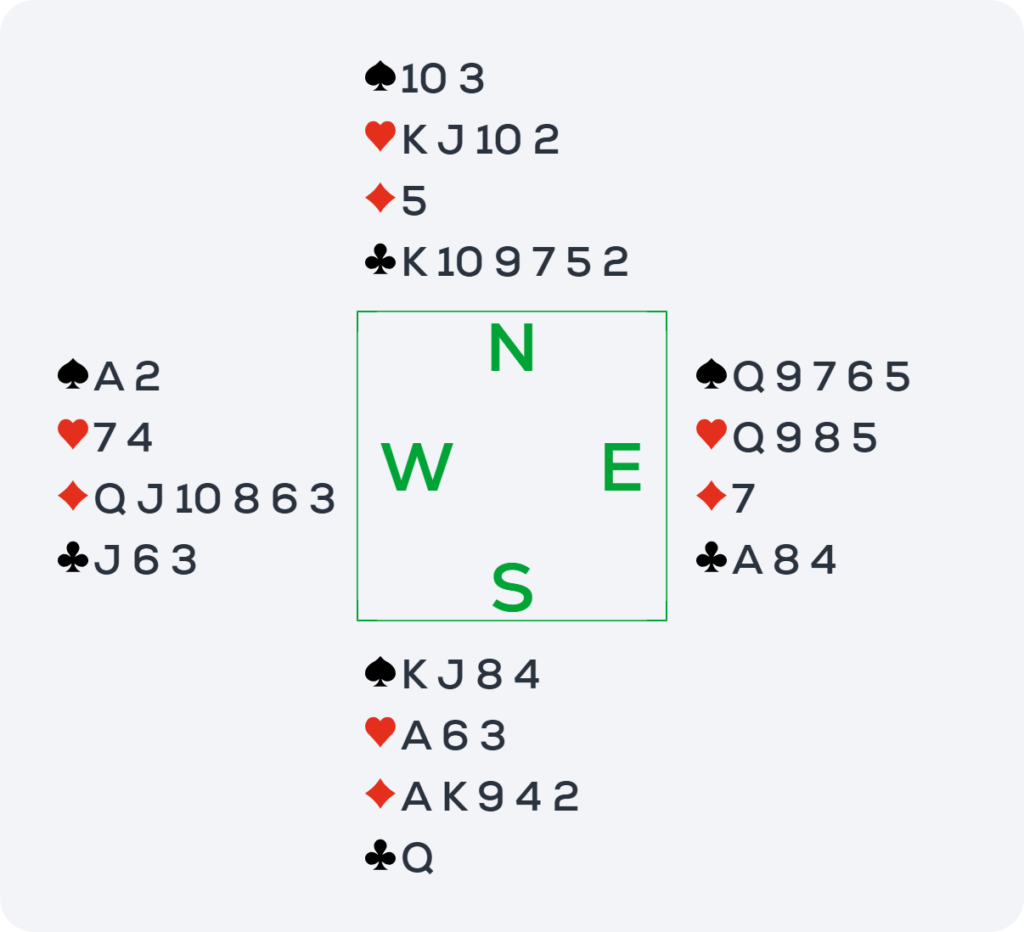
East could have made things more difficult by rising with the ace of clubs when I played a club from the dummy and then returning a heart. In that case, I would have needed to find a brilliant play: discarding the 10 of hearts from the dummy!
Indeed, if I tried the same tactic as before, East could unblock their queen of hearts and lock me in the dummy. I would then only make two diamonds, one spade, four hearts, and one club, which would be enough to go down. However, by discarding the 10 of hearts, I can score three spades, two diamonds, three hearts, and one club.
In the other room, they didn’t try to combine chances and went one down, earning 11 IMPs for “the good guys”!

Finn qualified to represent the United States as USA1!
This last hand came from the last set where our play was of little consequence since we were up by 60 but we still had to play carefully to avoid losing up our big margin. I was dealt:
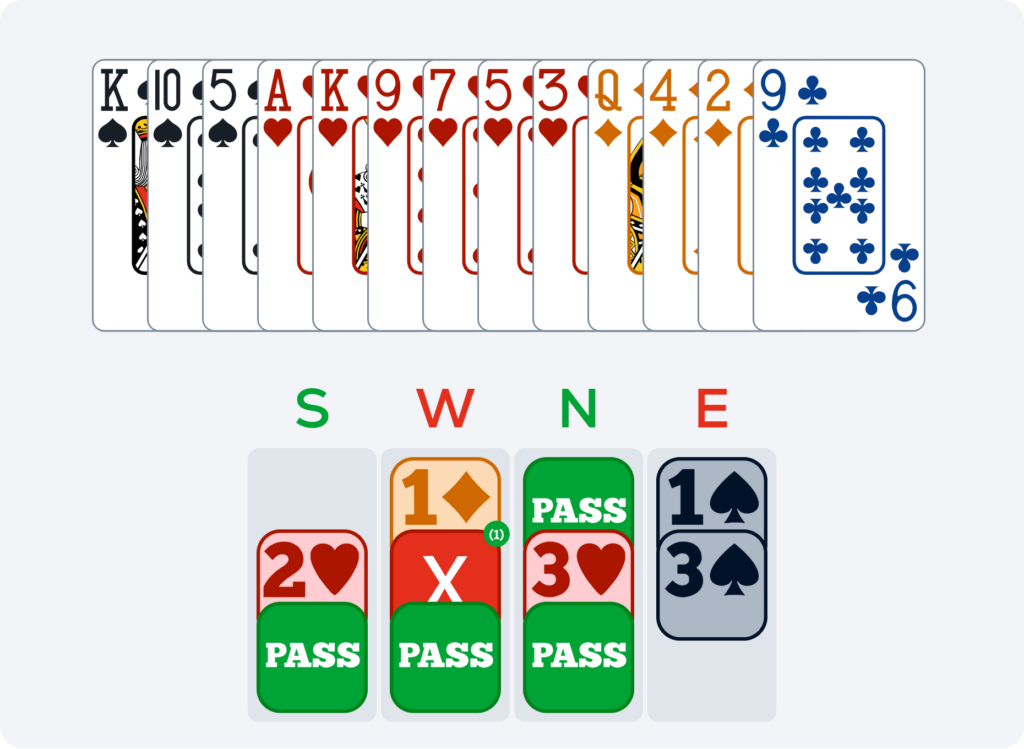
(1) X: three cards in spades
We play that if we lead the king holding ace-king and then switch suits, it shows a singleton. So, I decided to lead the king of hearts, and the dummy appeared with:
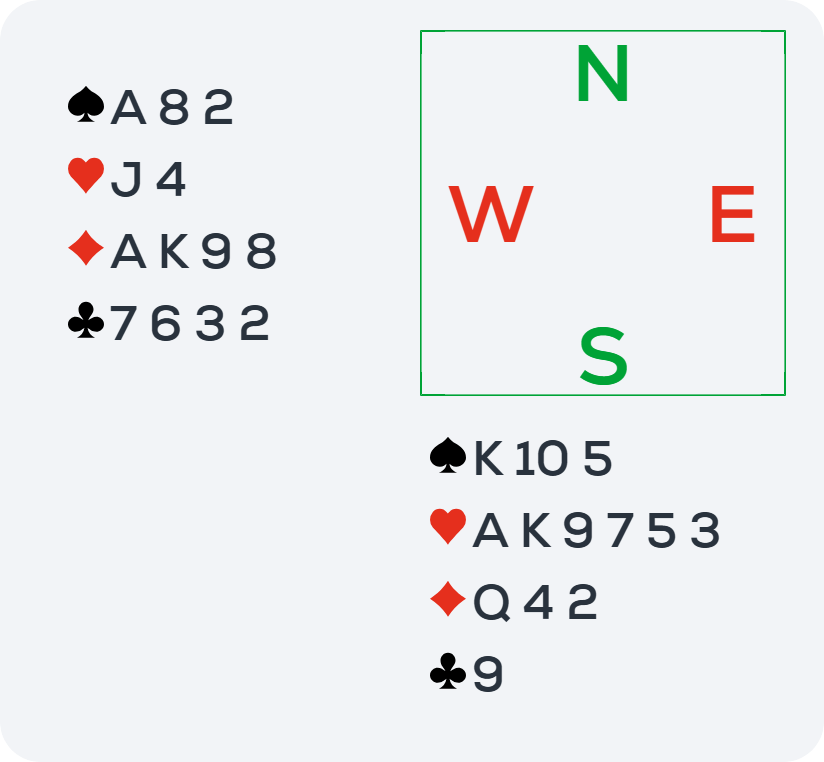
We played attitude signals, and my partner contributed the ♥8 while declarer played the ♥2. I switched to my singleton club, which my partner topped with the 10, taken by declarer’s ace. Declarer then led the jack of diamonds, appearing to attempt a finesse.
In such situations, it’s generally unwise to cover, as it may make life easier for declarer. However, with the 9 and 8 of diamonds on the dummy, it was entirely possible that declarer held jack-third or jack-doubleton and was setting up a double finesse. If they intended to finesse, they would likely do so anyway. Thus, I chose to cover with the queen. Declarer overplayed, then led a spade towards the 9.
This was an example of an intra-finesse, where declarer carefully manages dummy to attempt losing only one trick with J9xxx opposite A8x. The goal is to capture a doubleton 10 (with or without an honour) in my partner’s hand, which would otherwise present an insoluble problem. I won with the 10, and the lead was now mine.
One possibility was to hope my partner held the queen of hearts, allowing us to score a club ruff. But was this realistic? On the opening lead, the ♥8 seemed high, but what could my partner hold? He couldn’t have ♥8-third, as declarer would have played the 10 or queen in that case. Could it be ♥108x?
This is where trust in partnership agreements becomes critical. I trusted that my partner would have discouraged further heart leads more emphatically if he had a weaker holding. This suggested he held ♥Q108 and had played low to indicate strength! I played back the 3 of hearts to his queen (indicating a preference for clubs), and he played the queen of clubs, covered by declarer’s king.
At this point, I saw an opportunity for a safe deceptive play. Before proceeding, it was essential to analyse the rest of the hand. It seemed unlikely that declarer held the ♦10, as he would have played ace of spades followed by another spade to establish a diamond discard later. For example, with a distribution like ♠J9xxx ♥xx ♦J10 ♣Axxx or ♠J9xxx ♥xx ♦J10x ♣Axx.
I executed a small bluff by ruffing with the king of spades. This could give the illusion that it was my only remaining spade, encouraging declarer to feel secure enough to attempt a second finesse in diamonds. I ruffed with the king and then returned a diamond. Declarer finessed against the 10, which my partner immediately won with the jack of clubs. He then returned the jack of clubs, allowing me to discard my last diamond and enabling my partner to give me a diamond ruff. The result: three vulnerable down!
The full deal:
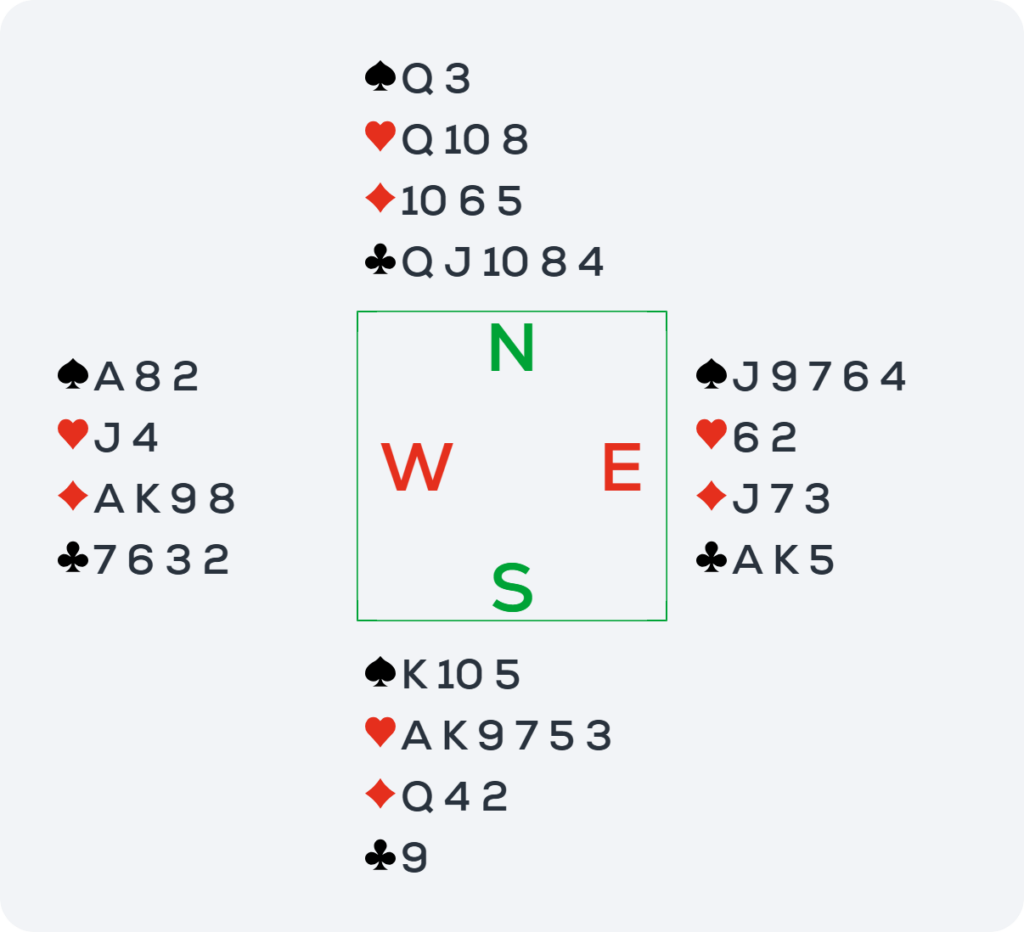
This was one of the first boards of the final set and did the job of shutting out the other team’s last hope.
We won the final set by 23 to win the match by 81 IMPs and book our tickets as USA1!

The fight to join the Junior team continues for Olivia
Team Kolesnik played great and we lost the match by 81 IMPs, but our team was happy to have a second chance in the USA2 final. It was a one-day match and we faced Team Chen. They are good players and tough competitors so we knew we would have to play well. Our teams are friendly with each other and we ended up getting dinner together the night before our match 🙂
Making your own luck!
There was an interesting defensive problem against 3NT in the first quarter.
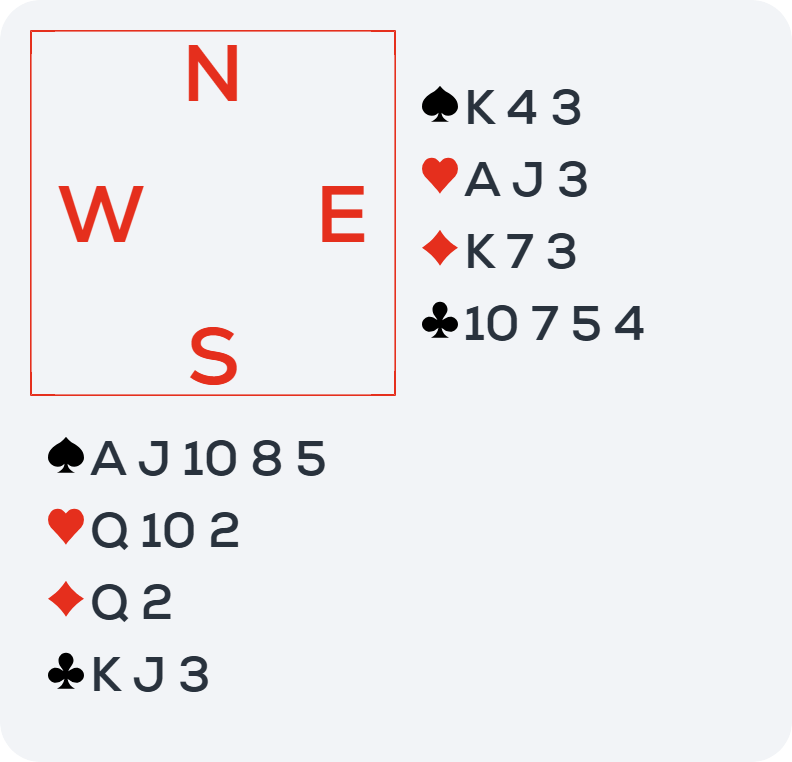
I opened 1♠, and West ended up playing in 3NT. My partner led the 9 of spades, which declarer won with the queen (I played the 2 as an encouraging signal).
Next, declarer played the ♥4 towards the jack on the dummy and my queen, with my partner contributing the 6 (low for an even count). Based on the visible honour points, I knew my partner could hold at most the jack of diamonds. I thought carefully and realised that declarer could still make the contract unless one highly unlikely configuration came into play.
Then I thought back to training camp. How could I make my own luck? In other words, how could I maximise declarer’s chances of going wrong? I had an idea: a sneaky queen of diamonds. If declarer had ATxx of diamonds, he could win the king of diamonds in dummy and try to finesse the 10 thinking I had the jack of diamonds as well.
Here was the hand:
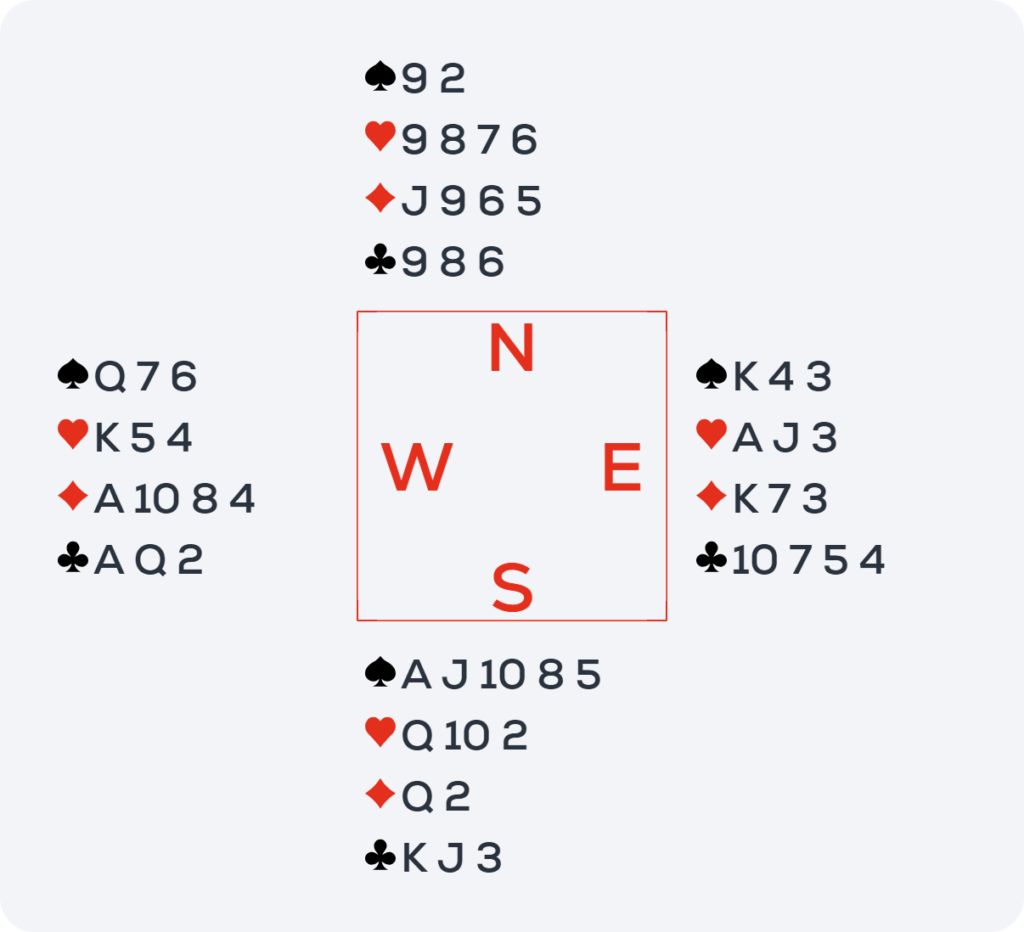
Declarer fell into my trap: they won in dummy with the king and played towards the 10. My partner took the jack and returned a spade. I cashed four spade tricks for two down, earning us 13 IMPs on the board.
To succeed after winning the diamond in dummy, declarer could have played a club. I would play low, and they’d win with the queen, cash the ace of diamonds, and two hearts. At that point, I’d be left with king-jack of clubs and spades in my hand. Declarer would then play the ace of clubs and another club, endplaying me to give up the king of spades!
If instead of playing the queen of diamonds, I had played the ace of spades and another spade, declarer could have succeeded by carefully identifying the dangerous opponent in clubs. I’m unsure what declarer would have done if I hadn’t chosen the queen of diamonds, but the goal here was to present an additional losing option on the board.
A very positive outcome for the new USA2 team

It was our day and we ended up winning by 126 IMPs.
We are thrilled and couldn’t be more excited to play for the US in Salsomaggiore this summer.
I had an amazing time playing with Stella and I can’t think of a better partnership reunion than this. Nine years ago, we had no idea that bridge would become this big a part of our lives. We were complete beginners that met at a Junior bridge night, got along well, and started playing together. What are the odds!
Now it’s time to practise and get in the best shape we can for this summer — maybe we can even get our revenge on USA1 😉
Did you like this article?
Share your opinion in the Comments section below.






Congrats, both of you!! <3
Very interesting! Thank you!